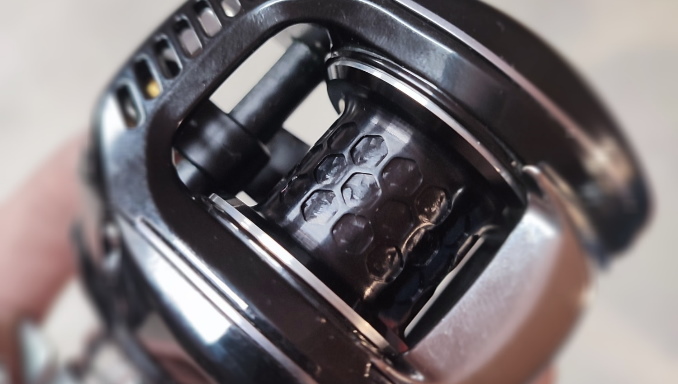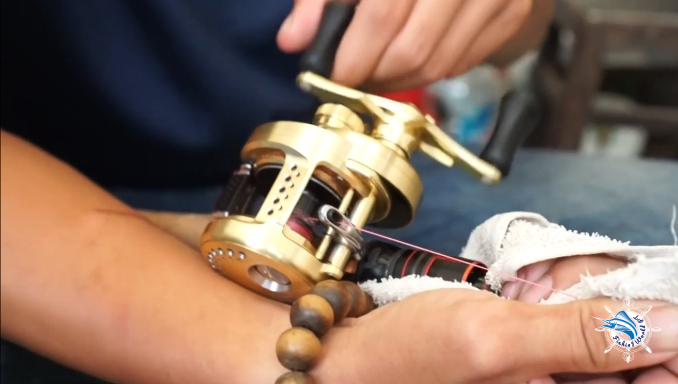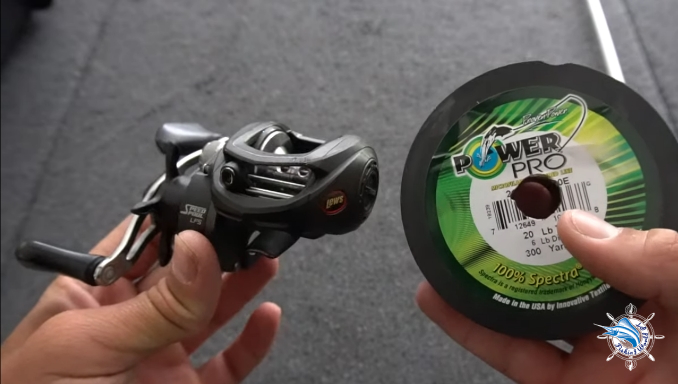How To Spool A Baitcasting Reel?

Today I will show you how to spool a baitcasting reel correctly. Stringing correctly is very important if you do it incorrectly. The fishing lines will be tangled during the fishing process, causing inhibition and discomfort.
Baitcaster is a type of reel that is difficult to use for new anglers. But once mastered, this reel is a great reel for anglers. I showed you how to spool a spinning in the previous post. Quite simple, right? You can refer to that article here: How to spool a spinning?
In general, putting new lines for the baitcaster is easier than spinning due to the special structure of the baitcaster’s spool. So if you have put a new line for Spinning, it will be relatively easy with a baitcaster. Well, without wasting your time, let’s get started.
This blog post will provide detailed instructions on how to spool a baitcasting reel so that you can successfully cast like a pro! Read on for helpful tips and tricks that will help hone your fishing expertise!
What will you need when spooling a baitcaster?
Before you spool your baitcasting reel, you will need a few items:
1) Baitcasting Reel – Choose a baitcasting reel that fits your needs, such as fresh or saltwater, heavy or light lures, and desired line capacity.
2) Rod – Select a rod that is similar in size to your baitcasting reel and is well-suited for the type of fishing you intend to do.
3) Line – Choose a line weight appropriate to the type of fishing you will be doing. Braided or monofilament lines may both work well. Monofilament is best for basic casting and braided line is good for more advanced techniques like skipping and flipping.
4) Bait – Select a bait that suits the fish you are trying to catch.
5) Backing – This is the thin layer of strong material between the spool and mainline and provides added strength to your reel should you get into a fight with a big fish.
6) Accessories – Depending on what kind of lures you’re using, you may need to add some accessories like split rings, swivels, and clips.
7) Pencil or Pen – You’ll need to mark the line at intervals, so having a writing utensil handy is important.
8) Scissors or a knife – Used to cut the spooling material when finished.
9) One fellow fisherman – A helpful hand is always nice when it comes to tasks like spooling a baitcasting reel.
What is a baitcasting reel?
Before learning about How to spool a baitcasting reel you need to understand baitcasting reel.
A baitcasting reel is a type of fishing reel that uses an internal spool to store the line.
This type of reel has its spool aligned parallel to the rod, making it ideal with mono, fluorocarbon, or braid lines that come off in a straight line from the spool – unlike spinning reels where line release deviates away from the rod itself.
A baitcasting reel is a type of fishing reel that uses centrifugal force to cast lures and baits. The design of the baitcasting reel allows anglers to achieve longer casts and greater accuracy when fishing than they could with most other types of reels.
Baitcasting is a technique recommended for more experienced anglers due to the complexities of its mechanics, as their spool movement must be precisely managed. If the reel moves faster than your casting line is flying, you might end up with a bird’s nest or backlash – a knotty mess of tangled lines and lost lures! Fortunately, these issues can become less frequent with practice; baitcasting offers remarkably enhanced fishability thanks to its versatility when using different types of baits and lines.
What are baitcasting reels’ benefits over other types of reels?
Baitcasting reels allow for longer, more accurate casts with greater control and precision. The design of the baitcasting reel also allows you to use heavier lines and lures than a spinning or fly fishing reel. This makes them ideal for catching larger fish in deeper waters as well as fishing in areas such as heavy vegetation where other types of reels may not be suitable. Additionally, baitcasting reels generate fewer line twists than spinning reels, giving anglers extra distance on their cast while maintaining accuracy when targeting specific areas or species of fish.
Pros:
- Better suited for underhand casts.
- Cast larger lures more effectively.
- Place bait in a specific spot.
- Cast farther and with more accuracy than ever before.
- With one hand free to hold your rod, casting becomes easier than ever.
- These reels are built to last with their durable construction and lighter weight.
- Spend less time dealing with line twists.
- Catch bigger fish with more power.
- Choose from a wider range of gear ratios for more versatility.
- Cast heavier lines and lures with ease.
Cons:
- Baitcasting reels require an extra level of finesse and training to use correctly.
- The potential for tangles and bird’s nests poses a particular challenge.
- Windy conditions or casting small lures can further complicate matters.
- Demand more maintenance than alternative options.
- Line tension must be adjusted depending on lure size.
- Investing in one will cost you more initially.
- Rubbing against rods when lines become bent resulting in potential line breakage.
Things to prepare to spool a baitcasting reel
In this article, I will show you how to spool a baitcaster by yourself or how to put fishing line on a baitcasting for those who don’t know or are new to fishing.
Of course, in order to enter new lines for the fishing reel, there must be a line. Fishing lines have many types, depending on where you fish and the type of fish you want to fish. And even the fishing reel will be suitable for a particular type of line. I showed you how to choose a fishing line in a previous post, you can refer to it here.
The second thing is a fishing rod, spinning, a cutter (a scissor is fine) and a cloth towel. Its job is to reduce the friction when putting the line to the reel.

How to spool a baitcaster?
First, to be able to put a new line on a baitcasting. You must know the following parts on the baitcaster’s spool.
- The first detail is level wind: A level wind fishing reel is a baitcasting reel with a level wind mechanism that automatically distributes lines evenly upon retrieval. A non-level wind reel lacks this mechanism. This is the part of pulling the line into the spool. Causing to lay evenly across the reel.
- There is a special structure on the spool of the baitcaster reel. Those are the holes located on the spool. These holes are responsible for helping us thread the line through and help the line roll close to the spool in the easiest way.
Steps to put line on a baitcaster reel
Place the news pull a line into a water bucket. This will stop the line tangling or spraying off the spool too much. They also help keep the lines from unraveling during spooling.
Take the end of the line and thread it back through the first eye of the fishing rod. This will make ruling the line onto the new spool easier.
Thread the fishing lines through the level wind. Then continue to thread the fishing line through one of the holes located on the spool. Spin the handle slightly until the spool makes one revolution.
Tie the fishing lines to the spool, remembering to use the knotting technique. Use scissors to cut the excess rope and pull the lines to hug the spool. If you are not familiar with this knotting technique, refer to my previous article on spinning. Or you can refer to other external websites.

Next, drop the new line reel into the bucket of water you prepared. Use a cloth towel to hold the fishing line so that it does not affect your hand. Now stretch it just enough for it to hug the spool.
Now you simply need to reel the lines onto the spool until it’s full. You want to leave a couple of millimeters away from the top of the sport to ensure you don’t overfill the real. As this can cause nasty tangles as too much line Springs off the reel when you cast. Now you have a fresh spool drill.
You see, it’s pretty simple, isn’t it? Some of you have asked me how to create The arbor knot correctly, below I will guide you how.
How to spool a baitcasting reel with braided line?
When spooling a fishing line, the type of material used matters. Fluorocarbon and monofilament are typically fed straight onto a reel without difficulty.
However, due to its slick properties, the braided line may suffer from drag issues, backlash, and slippage on the spool requiring some backing first for prevention.
So, braided lines require an extra step: some backing must be added first to ensure that any issues don’t cause slippage on the spool.
This explains why there are differences between these materials when it comes time to reel in a catch!
Get the best performance out of your reel by starting with a layer of mono fishing line. Feed it through the worm guide, tie it to the spool, and with a few revolutions of tension, create an even layer that’ll provide friction for improved performance when using braided lines after.
Connecting your braid to the monofilament using a knot gives you an extra layer of reinforcement for strength. Once secured, simply reel it onto your spool just as normal – setting aside approximately one-eighth inch from the lip of the spool when finished.
How to tie a arbor knot
- Take the line and go around the spool.
- Now, tie an overhand knot at the end of the lines.
- Take the tag with the overhand knot, cross over your mainline and go around, making a loop. The mainline should move freely through the loop.
- Now, tie a second overhand knot using the loop you made around the mainline, and tighten it down.
- Now, it’s time to cinch up the knot.
- Pull on the mainline, working it back and forth until the knot is nice and tight on the spool. Repeat if necessary.
- Now trim the tag a little less than a quarter inch.
Now you know all about How to spool a baitcasting reel, next you can choose the best fishing line for your reel.
Best line for baitcaster reels
When it comes to choosing the right line for your baitcasting reel, there’s no one-line solution. Different types of lines can provide unique advantages depending on what type of fishing you’re doing and how much experience you have in working with them. For example, monofilament is an ideal starting point if you are just beginning; due to its lower cost compared to other options as well as less tendency towards backlash when casting. Ultimately though, consider some experimentation – all three kinds of lines may be able to offer great results!
Braid: The perfect line type for the ultimate battle between you and your fish with a strength unrivaled by any other line. With its zero stretch properties, Braid is ideal to set hooks at a distance while simultaneously cranking big catches away from any potential obstructions they may face on their journey back in. While its visibility might be slightly higher than other lines, this could also create an advantage should situations arise that require lightning-fast reflexes – making every catch-all worth it!
Monofilament: While monofilament has the benefit of being less visible than braid, and easier to cast with on a bait caster due to its backlash-reducing properties; it also, unfortunately, comes with increased elasticity that may make setting your hook more challenging. Nonetheless, it can be beneficial in scenarios where topwater lures are used – as this line floats right at the surface!
Fluorocarbon: has many advantages for anglers, like its ability to sink and be virtually invisible in clear waters. However, this convenience does come with a cost as fluorocarbon is usually more expensive than a mono-fishing line. Additionally, it tends to generate greater backlash on baitcasting reels compared to other lines.
With so many different lines available, finding the right one for your intended use can be a challenge. But if finesse is what you seek, mono or fluoro will provide results to exceed expectations!
How much line do you put on a baitcaster?
Sometimes you don’t need so many lines on your reel. So to avoid wasting your new line, you can use the backing to half fill the spool up.
The backing is just a word for some cheap, thick lines that you can start filling the spool up with before finishing off with the line you want to fish with.
It’s important to fill your reels full. Casting reels should be between 1/8 inches from the top to the top. If you put too many lines on them, they will make strange sounds when you cast. Baitcasting reels should be all the way full, right to the top. The line will jump off the spool in coils if you get too much on them.
FAQs
Is spooling a reel easy?
Yes, generally, spooling a reel is simple. Learning how to spool a baitcasting reel can be easy or difficult depending on the kind of material used. Monofilament and fluorocarbon are relatively easy to spool, but braided line requires extra effort due to their slippery composition. When dealing with braid, it’s important to have some form of backing in place to reduce potential slippage or backlash caused by drag on the spool.
To maximize the functionality of a spinning reel, proper spooling techniques must be observed. Otherwise, you may experience reduced performance capabilities with your equipment.
Should you wet the braid before spooling a baitcasting reel?
No, braid requires no pre-soaking – a task often necessary with monofilament.
Why does my bait caster backlash every cast?
When casting, a backlash occurs when the spool spins too quickly after being released. This causes the line to come off at an accelerated rate and can be difficult to manage with precision.
Baitcasting reels are a delicate balance – too much or too little pressure on the spool can cause an undesirable backlash. For successful casting, try to maintain a consistent speed of line output compared with the turning rate of the reel’s spool for maximum efficiency and accuracy.
Do I need to use a different knot when tying the braid?
No – all popular knots are suitable! It’s simply important to ensure that you have tied the knot securely and have left no loose ends. Additionally, some knots can offer additional layers of stability such as the FG Knot which is commonly used with braided lines.
The right fishing line can make all the difference – whether your focus is power or finesse – so try out each type until you find what works best for you! With some experimentation, understanding, and practice; anglers everywhere can take their catches to new heights!
What size backing should I use?
It depends on what type of fishing you’re doing and how many lines you plan on bringing with you. For most applications, a 40-50 lb test works well – just make sure it isn’t too weak for your setup or too strong for depleted knots! If in doubt, err on the side of caution and choose a stronger one.
Should I add resistors to my braid?
Resistors help reduce friction when casting and can help with preventing backlash. They’re not essential but can be useful depending on your situation. If you’re noticing a lot of backlashes and want to reduce them, then resistors may be worth a try! Overall, the type of line you choose is up to you and depends on what application you plan on using it for. Each material has its unique strengths and weaknesses – so finding the right one is a matter of trial and error as well as personal preference! With that said, mastering spooling braided lines takes practice – but once done successfully, anglers everywhere can maximize their catches!
Why do you soak fishing line before spooling a baitcaster?
Soaking your fishing line before spooling (not only baitcaster) can help to reduce friction and provide a smoother line while casting. Monofilament, especially, needs to be soaked in water for at least thirty minutes before spooling since it doesn’t handle tension as well as other lines. This helps you avoid tangles and fraying that could come from over-spinning the reel with the dry line! Soaking the line provides added protection against the elements and makes sure it is ready for use when you hit the water.
How do you spool lines without memory?
Memory is the tendency of a fishing line to retain its original shape when wound on a spool. To spool lines without memory, you should make sure that your line is stretched out and warm before winding it onto the reel. You can also use water or a silicone-based lubricant (such as WD-40) to reduce friction while winding. Additionally, you can use rubber bands or weights placed around the spool to keep the tension even while winding.
Finally, make sure that your reels are properly functioning and in good condition before beginning – otherwise, any issues with them could lead to unwanted memory forming on the line! The proper spooling of the braid ensures maximum efficiency when angling and can make the difference between a successful outing and not. With careful attention, you can master spooling braid with precision and increase your chances of catching more fish! Good luck out there!
Conclusion
By following these steps will help you spend more time fishing and less time messing with a tangled mess.
You already have the answer to the “How to spool a baitcasting reel?”. Remember, everything depends on your personal preferences. Any reels are expensive or cheap, it will still be useless if you can’t master them.
I hope this article is helpful to you. Do you have another idea?
Thanks for reading our article about how to spool a baitcaster. If you have any questions, leave a comment below. You can see more posts on our website.
Hope you got your questions answered. Good luck!
Further reading:
- Other info about fishing in Fishingandhuntingsports
- Fishing reel Wikipedia
- What line should I put on my baitcaster

